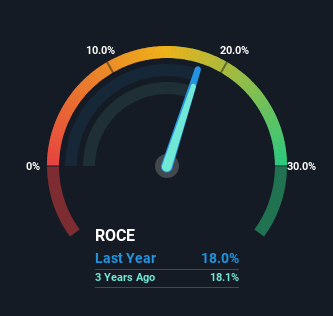- India
- /
- Healthcare Services
- /
- NSEI:KIMS
Returns Are Gaining Momentum At Krishna Institute of Medical Sciences (NSE:KIMS)

What trends should we look for it we want to identify stocks that can multiply in value over the long term? Firstly, we'd want to identify a growing return on capital employed (ROCE) and then alongside that, an ever-increasing base of capital employed. Put simply, these types of businesses are compounding machines, meaning they are continually reinvesting their earnings at ever-higher rates of return. So when we looked at Krishna Institute of Medical Sciences (NSE:KIMS) and its trend of ROCE, we really liked what we saw.
Understanding Return On Capital Employed (ROCE)
Just to clarify if you're unsure, ROCE is a metric for evaluating how much pre-tax income (in percentage terms) a company earns on the capital invested in its business. To calculate this metric for Krishna Institute of Medical Sciences, this is the formula:
Return on Capital Employed = Earnings Before Interest and Tax (EBIT) ÷ (Total Assets - Current Liabilities)
0.18 = ₹4.7b ÷ (₹29b - ₹3.0b) (Based on the trailing twelve months to March 2023).
Thus, Krishna Institute of Medical Sciences has an ROCE of 18%. On its own, that's a standard return, however it's much better than the 14% generated by the Healthcare industry.
Check out our latest analysis for Krishna Institute of Medical Sciences

Above you can see how the current ROCE for Krishna Institute of Medical Sciences compares to its prior returns on capital, but there's only so much you can tell from the past. If you'd like to see what analysts are forecasting going forward, you should check out our free report for Krishna Institute of Medical Sciences.
So How Is Krishna Institute of Medical Sciences' ROCE Trending?
We like the trends that we're seeing from Krishna Institute of Medical Sciences. The data shows that returns on capital have increased substantially over the last five years to 18%. The company is effectively making more money per dollar of capital used, and it's worth noting that the amount of capital has increased too, by 1,168%. This can indicate that there's plenty of opportunities to invest capital internally and at ever higher rates, a combination that's common among multi-baggers.
On a related note, the company's ratio of current liabilities to total assets has decreased to 10%, which basically reduces it's funding from the likes of short-term creditors or suppliers. This tells us that Krishna Institute of Medical Sciences has grown its returns without a reliance on increasing their current liabilities, which we're very happy with.
The Bottom Line
In summary, it's great to see that Krishna Institute of Medical Sciences can compound returns by consistently reinvesting capital at increasing rates of return, because these are some of the key ingredients of those highly sought after multi-baggers. Since the stock has returned a solid 53% to shareholders over the last year, it's fair to say investors are beginning to recognize these changes. With that being said, we still think the promising fundamentals mean the company deserves some further due diligence.
If you want to continue researching Krishna Institute of Medical Sciences, you might be interested to know about the 1 warning sign that our analysis has discovered.
If you want to search for solid companies with great earnings, check out this free list of companies with good balance sheets and impressive returns on equity.
If you're looking to trade Krishna Institute of Medical Sciences, open an account with the lowest-cost platform trusted by professionals, Interactive Brokers.
With clients in over 200 countries and territories, and access to 160 markets, IBKR lets you trade stocks, options, futures, forex, bonds and funds from a single integrated account.
Enjoy no hidden fees, no account minimums, and FX conversion rates as low as 0.03%, far better than what most brokers offer.
Sponsored ContentValuation is complex, but we're here to simplify it.
Discover if Krishna Institute of Medical Sciences might be undervalued or overvalued with our detailed analysis, featuring fair value estimates, potential risks, dividends, insider trades, and its financial condition.
Access Free AnalysisHave feedback on this article? Concerned about the content? Get in touch with us directly. Alternatively, email editorial-team (at) simplywallst.com.
This article by Simply Wall St is general in nature. We provide commentary based on historical data and analyst forecasts only using an unbiased methodology and our articles are not intended to be financial advice. It does not constitute a recommendation to buy or sell any stock, and does not take account of your objectives, or your financial situation. We aim to bring you long-term focused analysis driven by fundamental data. Note that our analysis may not factor in the latest price-sensitive company announcements or qualitative material. Simply Wall St has no position in any stocks mentioned.
About NSEI:KIMS
Krishna Institute of Medical Sciences
Provides medical and health care services under the KIMS Hospitals brand name in India.
Exceptional growth potential with questionable track record.
Market Insights
Community Narratives



